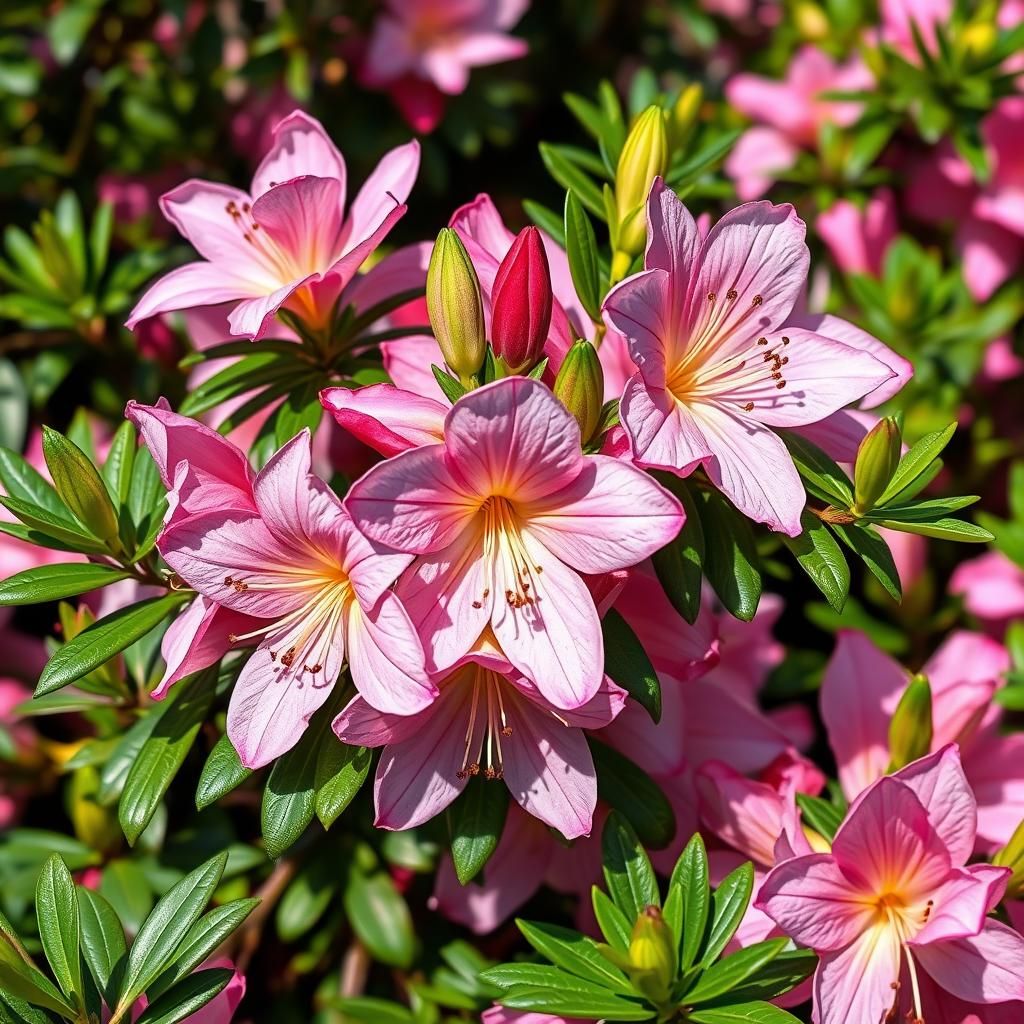Discover the Best Sun Tolerant Azaleas Australia: A Guide for Garden Enthusiasts

When it comes to enhancing the beauty of Australian gardens, azaleas are a top choice for many enthusiasts. However, finding varieties that can thrive in sunny conditions can be challenging. This guide aims to introduce you to the best sun-tolerant azaleas suitable for Australia's diverse climate. Discover the unique features, optimal care, and planting tips for these vibrant plants that can add color and elegance to your outdoor spaces. Whether you’re a seasoned gardener or a beginner, our comprehensive insights will help you select the perfect sun-loving azaleas to elevate your garden's aesthetic appeal.
Sun Tolerant Azaleas in Australia
In Australia, sun tolerant azaleas have gained popularity due to their vibrant blooms and adaptability to various climates, particularly in regions that experience ample sunlight. These azaleas, which belong to the Rhododendron genus, are specifically bred to withstand direct sunlight, making them an excellent choice for gardeners looking to enhance their landscapes. When planted in well-drained soil and provided with consistent moisture, sun tolerant azaleas can flourish, offering a stunning display of color during the blooming season. Their resilience against harsh conditions allows Australians to enjoy these beautiful flowers in gardens that receive full sun exposure, adding to their appeal.
Characteristics of Sun Tolerant Azaleas
Sun tolerant azaleas have specific characteristics that distinguish them from other varieties. These plants are usually more robust, featuring thicker leaves that help minimize water loss and reduce the risk of sunburn. They typically possess a compact growth habit, making them ideal for smaller gardens or as foundation plants. Additionally, they showcase an array of vibrant colors, from soft pastels to bright hues, allowing for versatile landscaping options. Their ability to thrive in sunny conditions without compromising flower quality is a key trait of this type of azalea.
Best Varieties for Sunny Conditions
Several varieties of sun tolerant azaleas have been developed for Australian climates. Some of the most popular include 'Hino Crimson', known for its vibrant red flowers, and 'Kurume', which offers a range of colors and is particularly hardy. Another standout is 'G.G. Gerbing', a deciduous azalea that features clusters of bright pink blooms. These varieties are recommended for their sun resilience and consistent performance in warmer weather, making them favorites among gardeners who desire a splash of color in their outdoor spaces.
Caring for Your Sun Tolerant Azaleas
Caring for sun tolerant azaleas requires attention to specific needs that cater to their thriving in sunny environments. Firstly, they should be planted in well-draining soil that retains sufficient moisture without becoming waterlogged. Regular watering is essential, particularly during dry spells; however, overwatering must be avoided to prevent root rot. Fertilizing in early spring with a balanced azalea-specific fertilizer will promote healthy growth and blooming. Additionally, applying mulch can help retain soil moisture and regulate temperature around the roots.
Common Pests and Diseases
Like any plant, sun tolerant azaleas can be susceptible to certain pests and diseases. Common pests include aphids, which can be managed through insecticidal soap, and spider mites, which often thrive in dry conditions. Diseases such as phytophthora root rot can occur if the plants are overwatered or planted in poorly draining soil. Keeping an eye on the health of your azaleas and promptly addressing any infestations will help ensure their longevity and beauty in the garden.
Landscaping Ideas with Sun Tolerant Azaleas
Incorporating sun tolerant azaleas into landscape design can add striking visual interest to outdoor spaces. They can be used as focal points in garden beds, offering vibrant color contrasts with other perennials and shrubs. Planting them along walkways or at the front of a home can create inviting curb appeal. Consider utilizing them in mixed borders, where their blooms can harmonize with seasonal flowers, further enhancing the garden’s aesthetic. Grouping different varieties can also create a dynamic effect, showcasing a range of colors and textures.
| Variety | Color | Height |
|---|---|---|
| Hino Crimson | Red | 2-3 ft |
| Kurume | Various | 2-4 ft |
| G.G. Gerbing | Pink | 2-3 ft |
Which azalea is best for full sun?

When considering azaleas that thrive in full sun conditions, two varieties stand out: the Southern Indian Azalea and the Encore Azalea. Both types of azaleas are known for their resilience, vibrant blooms, and adaptability to sunny environments.
Southern Indian Azalea
The Southern Indian Azalea is a popular choice for gardeners looking for a plant that can withstand full sunlight. This azalea is native to the southeastern United States and prefers acidic soils, making it ideal for areas that receive ample sunshine.
- Maintenance: Requires regular watering, especially during dry spells.
- Fertilization: Benefits from acidic fertilizers to maintain vibrant blooms.
- Blooms: Produces large, colorful flowers in shades of pink, red, and white.
Encore Azalea
The Encore Azalea is known for its ability to bloom multiple times throughout the year, making it an excellent choice for gardeners who want ongoing color. This azalea hybrid can tolerate full sun and is more resilient to heat than traditional varieties.
- Flowering Season: Blooms in spring, summer, and fall, providing extended color.
- Soil Requirements: Prefers well-drained, acidic soil to flourish.
- Size: Generally reaches a height of 2 to 4 feet, making it suitable for borders and containers.
Planting Location
Choosing the right location for planting your azalea is crucial for its growth, especially in full sun. While azaleas can tolerate full sun, they can also benefit from some afternoon shade to protect them from extreme heat.
- Sun Exposure: Ideally, they should receive at least 6 hours of sunlight.
- Soil Type: Ensure you have well-draining soil to prevent root rot.
- Spacing: Space plants adequately to allow for air circulation and growth.
Watering Needs
Proper watering is essential for the health of azaleas, particularly in full sun where evaporation can be rapid.
See also:
- Frequency: Water deeply once a week, increasing during extreme heat.
- Mulching: Apply mulch to retain moisture and keep roots cool.
- Signs of Stress: Watch for wilting or leaf drop as indicators of insufficient water.
Pest and Disease Management
Full sun azaleas can be susceptible to specific pests and diseases that thrive in warm environments.
- Pests: Keep an eye out for aphids and lace bugs, which can damage foliage.
- Diseases: Root rot and powdery mildew can occur if plants are overwatered or not adequately ventilated.
- Prevention: Regularly inspect plants and use organic pesticides when necessary.
Can azaleas handle hot afternoon sun?

Azaleas are beautiful flowering shrubs that are often prized for their vibrant blooms and lush foliage. However, their sensitivity to temperature and light conditions necessitates a careful approach to how they are positioned in a garden, particularly concerning hot afternoon sun.
Understanding Azalea Sun Requirements
Azaleas prefer environments that provide partial shade rather than full sun exposure, especially during the intense heat of the afternoon. Here are a few critical factors to consider about their sun requirements:
- Shade Tolerance: Azaleas thrive in areas with dappled sunlight or partial shade, which mimics their natural habitat under hardwood trees.
- Heat Sensitivity: Direct and prolonged exposure to hot afternoon sun can stress the plants, leading to scorched leaves and hindered growth.
- Flowering Impact: Too much sun can cause blooms to fade quickly and reduce the overall flowering potential of the shrub.
Effects of Hot Afternoon Sun on Azaleas
When azaleas are subjected to intense afternoon sunlight, their health can significantly decline. The effects of excessive heat include:
- Leaf Scorch: Leaves may develop brown margins and tips, a clear sign of sunburn due to dehydration.
- Reduced Water Retention: High temperatures lead to increased transpiration, making it difficult for the plants to absorb necessary moisture.
- Stunted Growth: Prolonged exposure can result in reduced vigor, affecting both the size of the plant and its flowering capacity.
Ideal Planting Locations for Azaleas
To ensure proper growth, azaleas should be planted in locations that minimize exposure to hot afternoon sun. Consider these guidelines for optimal placement:
- Northern Exposure: Planting azaleas on the north side of a building or under taller vegetation can protect them from intense sun.
- Eastern Orientation: An east-facing garden allows morning sun, providing warmth without the harshness of afternoon rays.
- Natural Shade Sources: Utilize existing trees or structures to create a shaded microclimate for your azaleas.
Care Tips for Azaleas in Sunny Areas
If azaleas are already planted in a sunnier location, certain care techniques can help them withstand hot afternoon sun. Here are some effective tips:
- Mulching: Applying a thick layer of mulch retains soil moisture and keeps root temperatures cooler.
- Regular Watering: Ensure consistent watering, especially during dry spells to keep the soil adequately hydrated.
- Pruning: Regularly prune azaleas after blooming to improve air circulation and reduce heat stress on the plants.
Signs Your Azaleas Are Overexposed
Being aware of stress signals can help in managing azaleas that might be suffering from excessive sunlight. Key signs include:
- Wilting Leaves: Leaves that droop or wilt, especially in the heat of the day, indicate insufficient water due to stress.
- Discoloration: A change in leaf color, particularly yellowing or browning, signals that the plant is struggling to cope with its conditions.
- Pest Issues: Stressed plants are more susceptible to pests and diseases, often showing signs of infestations as a secondary problem.
Can azaleas take too much sun?

Azaleas are beautiful flowering shrubs that are popular in many gardens, but their sunlight requirements can be somewhat specific. While they do thrive in bright light, excessive sunlight can be detrimental to their health. Generally, azaleas prefer partial shade and can sometimes experience stress if they receive too much direct sunlight. This exposure can lead to issues such as leaf scorch, where the leaves turn brown around the edges and may drop prematurely. Therefore, it's essential to ensure that azaleas receive the appropriate amount of sunlight to maintain their vigor and bloom quality.
Understanding Azalea Sunlight Needs
Azaleas typically flourish in conditions that provide them with morning sun and afternoon shade. This balance allows them to absorb the necessary light without suffering from the heat of the day. When planting azaleas, it's important to consider:
- Exposure Duration: Limit direct sun exposure to about 4-6 hours daily.
- Heat Intensity: Areas with high summer temperatures can exacerbate sunlight stress.
- Microclimates: The surrounding environment can affect sunlight exposure, including nearby structures and trees.
Symptoms of Too Much Sun
When azaleas receive more sunlight than they can handle, they display several symptoms indicating stress. These signs help gardeners understand when to adjust their plants’ conditions:
- Leaf Scorch: Leaves may turn crispy and brown on the edges.
- Wilting: Plants may appear droopy due to intense heat and lack of moisture.
- Reduced Bloom: Flowers may be fewer in number and less vibrant.
Best Locations for Planting Azaleas
Choosing the right location for azaleas is crucial for their health and growth. Ideal spots provide a mix of light and protection. Consider the following when selecting a planting site:
See also:
- Near Trees: Planting under deciduous trees can offer shade during the hottest parts of the day.
- East or North Side of Structures: These areas receive softer, filtered light.
- Avoid West-facing Locations: Direct afternoon sun can be too harsh for azaleas.
Maintaining Healthy Azaleas
Proper care can help azaleas thrive even in slightly sunnier conditions. Some essential practices include:
- Regular Watering: Ensure consistent moisture without waterlogging; azaleas prefer well-drained soil.
- Mulching: Applying a layer of mulch can help retain soil moisture and moderate temperature.
- Fertilization: Use fertilizers designed for acid-loving plants to promote healthy growth during the blooming season.
Adjusting Conditions for Sun-Stressed Azaleas
If azaleas show signs of stress due to too much sunlight, there are various adjustments that can support their recovery:
- Relocation: Consider moving them to a shadier spot if feasible.
- Temporary Shade Solutions: Use shade cloth or neighboring potted plants to provide relief.
- Hand-Watering: Increase watering frequency but ensure proper drainage to prevent root rot.
Do azaleas like full sun in Australia?

Azaleas generally prefer partial shade rather than full sun, particularly in Australia due to the country's contrasting climates and intense sunlight. While they can tolerate some sunlight, prolonged exposure to full sun could lead to stress, burnt leaves, and ultimately affect their overall health. In Australia, where summers can be particularly harsh, it is advisable to plant azaleas in areas that receive morning sunlight and afternoon shade. This creates an ideal environment for optimal growth and flowering.
Optimal Light Conditions for Azaleas
Azaleas thrive under specific light conditions that can significantly impact their growth and blooming capacity. They require:
- Morning Sun: Exposure to the soft morning sunlight is beneficial.
- Afternoon Shade: Protecting them from the harsh afternoon sun helps avoid leaf scorch.
- Filtered Light: Dappled light through trees can provide a perfect balance of sun and shade.
Soil Requirements for Healthy Growth
The type of soil in which azaleas are planted is equally important as light exposure. They prefer:
- Well-draining Soil: Soil that allows excess moisture to escape prevents root rot.
- Acidic pH: Azaleas thrive in slightly acidic soils, typically pH 5.0 to 6.0.
- Organic Matter: Incorporating compost or mulch improves soil fertility and structure.
Watering Needs
Proper watering practices are essential for the survival of azaleas, particularly in full sun conditions. They need:
- Consistent Moisture: The soil should be kept consistently moist but not soggy.
- Deep Watering: Watering deeply encourages roots to grow deeper into the soil.
- Mulching: Applying mulch helps retain moisture and regulate soil temperature.
Pest and Disease Management
Azaleas can be vulnerable to various pests and diseases, especially when stressed by full sun exposure. Common issues include:
- Leaf Spot: Caused by fungal infections, represents a significant concern in overly sunny areas.
- Azalea Lace Bug: An insect that causes damage by feeding on the leaves, especially in warm, sunny conditions.
- Root Rot: Excess moisture combined with poor drainage can lead to root diseases.
Best Practices for Planting Azaleas in Australia
When planning to plant azaleas in Australia, specific strategies can enhance their adaptability to local conditions:
- Choose the Right Location: Opt for a spot with protection from the harshest sun.
- Timing of Planting: Early spring or fall is the best time to plant to avoid extreme temperatures.
- Regular Care: Routine pruning and fertilizing can help maintain their health and vigor.
Questions from Our Readers
What are sun tolerant azaleas?
Sun tolerant azaleas are a type of azalea that can thrive in full sun conditions, as opposed to the more common varieties that prefer shaded environments. These plants have adapted to withstand higher light exposure while still maintaining their vibrant flowers and overall health, making them an excellent choice for sunny Australian gardens.
How do I care for sun tolerant azaleas in Australia?
Caring for sun tolerant azaleas involves ensuring they receive sufficient water, especially during the hot summer months. It is important to choose well-draining soil and apply a layer of mulch to help retain moisture. Additionally, a balanced fertilizer should be applied in early spring to promote healthy growth and blooming.
Can sun tolerant azaleas handle drought conditions?
While sun tolerant azaleas are more resilient than traditional azaleas, they still prefer consistent moisture. They can tolerate short periods of drought, but prolonged dry spells may lead to stress and affect flower production. It is recommended to provide supplemental watering during dry spells to ensure their vitality.
Which varieties of sun tolerant azaleas are recommended for Australian gardens?
Some recommended varieties of sun tolerant azaleas for Australian gardens include 'Sunset Pink,' 'Summer Glow,' and 'Rosy Glow.' These varieties have shown excellent performance in sunny conditions and offer a stunning array of colors and blooms, making them popular choices for landscaping in warmer climates.
See also:

If you want to read more articles like Discover the Best Sun Tolerant Azaleas Australia: A Guide for Garden Enthusiasts, we recommend you check out our Shrubs category.
Leave a Reply
Related Articles